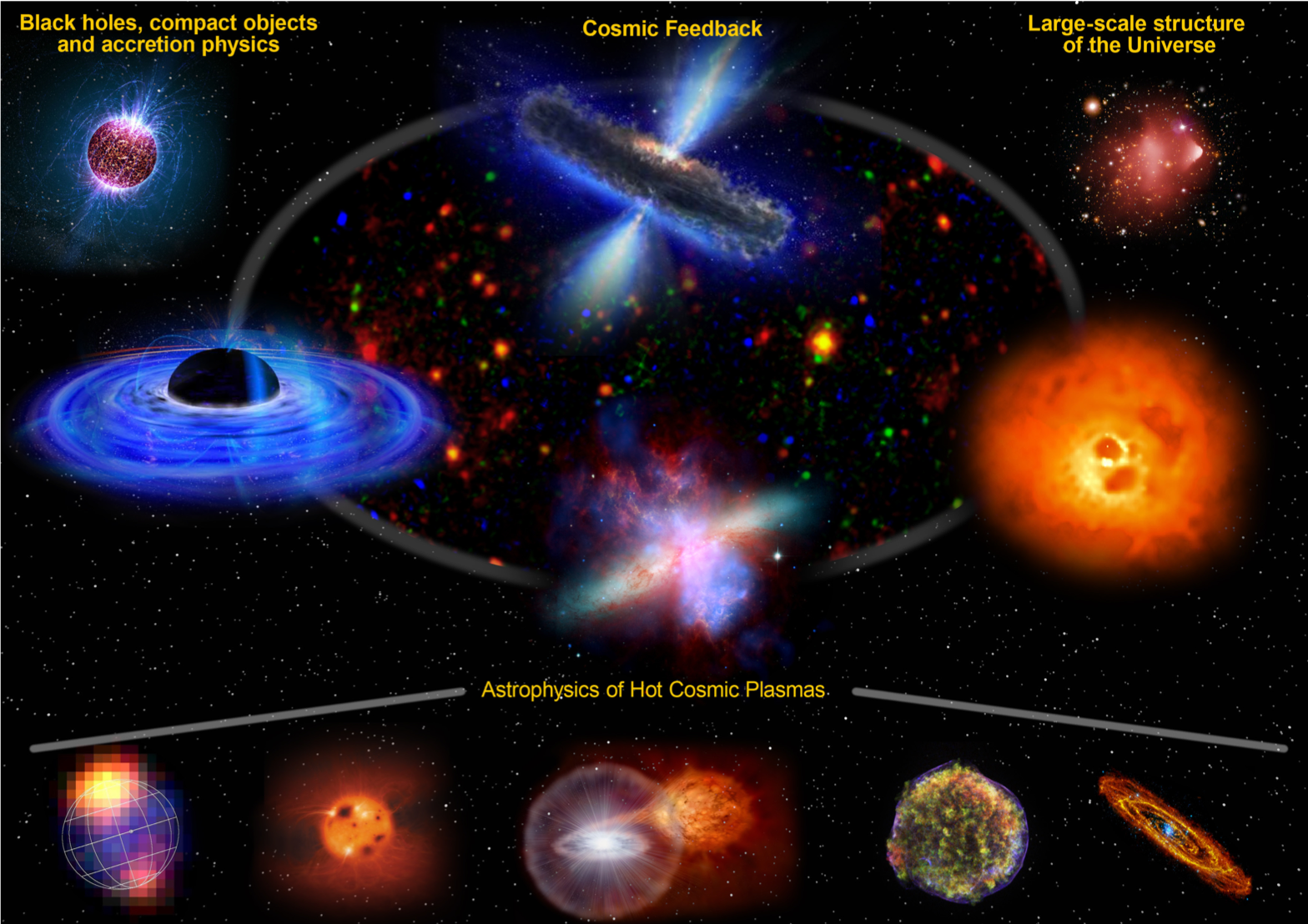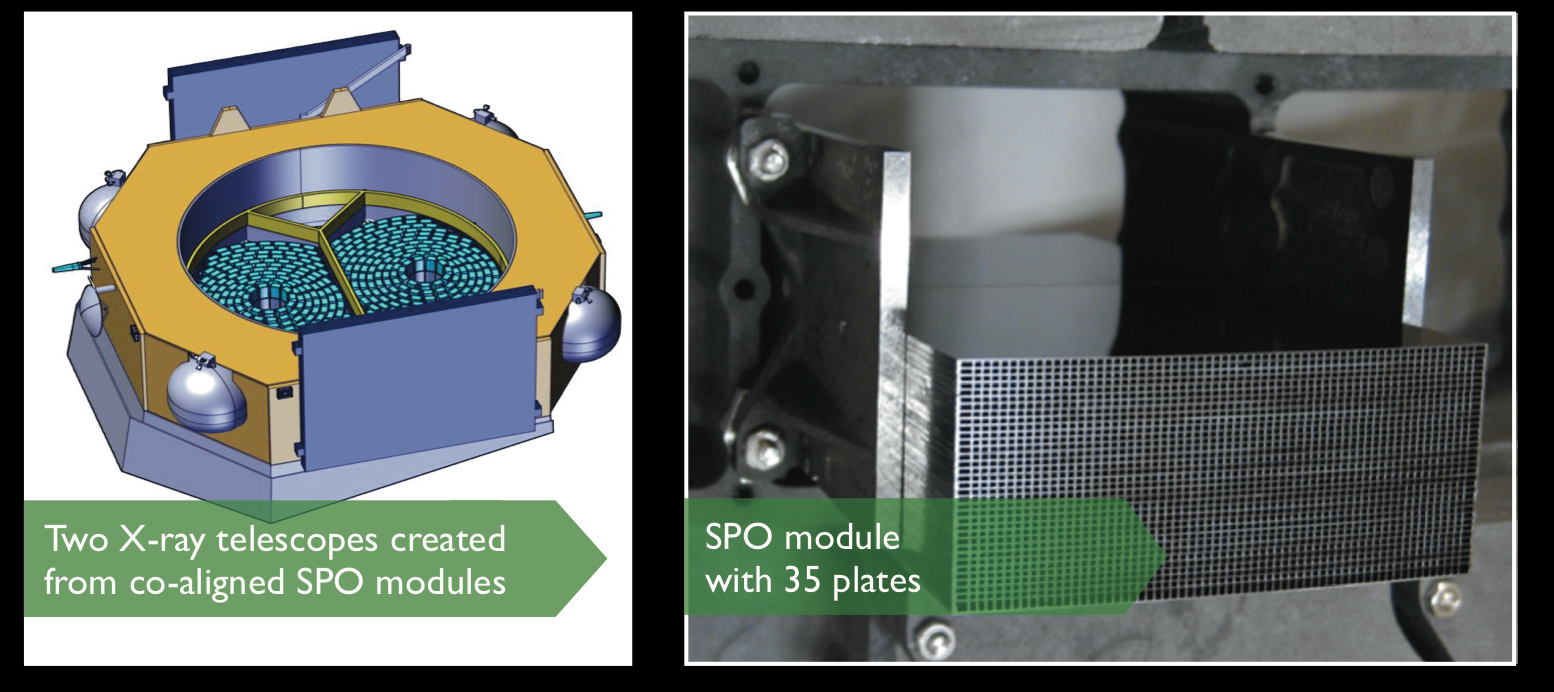|
Athena: the Extremes of the Universe from Black Holes to Large-scale Structure
Rome, Italy, March 22, 2012 Home - Athena in a nutshell - Programme - List of participants - Registration - Local info |
The Athena Mission...in a Nutshell
Core Science Objectives
- Black holes & accretion physics
- Map the innermost region around accreting black holes and other compact objects and probe matter under strong gravity and high density conditions.
- Cosmic feedback
- Reveal the physics of feedback from AGN and starbursts on all scales; quantify supermassive black hole growth and its relationship to galaxy evolution.
- Large-scale structure of the Universe
- Trace the formation and evolution of large-scale structure via hot baryons in galaxy clusters, groups and the intergalactic medium comprising the cosmic web.
- Diagnose hot cosmic plasmas in all astrophysical environments.

Artist's illustration of Athena's science goals, linking phenomena occurring around black holes to the large-scale structure of the Universe through cosmic feedback. The cartoon also illustrates some local and distant environments where Athena's observations will reveal the state of astrophysical hot plasmas.
Scientific performance requirements
| Parameter | Performance requirement | Science Goals |
|---|---|---|
| Effective Area (total for 2 telescopes) | 1 m2 @ 1.25 keV (goal of 1.2 m2) 0.5 m2 @ 6 keV (goal of 0.7 m2) |
Black hole evolution, large-scale struct. Strong gravity, equation of state |
| Spectral resolution (FWHM) | ΔE=3 eV (@6 keV) in 2′ × 2′ (goal of 2.5 and 3′ × 3′) ΔE=150 eV (@6 keV) in 24′ × 24′ (goal of 125 and 28′ × 28′) |
Cosmic feedback, large-scale structure. Black hole evolution |
| Angular resolution | 10′′ HPD (0.1—6 keV) (goal of 5′′) |
Cosmic feedback, black hole evolution |
| Sensitivity (0.5—2 keV) | 4 × 10-17 erg cm-2 s-1 (goal of 2 × 10-17 erg cm-2 s-1) |
Black hole evolution |
| Count Rate (WFI) | 1 Crab with > 90% throughput ΔE < 200 eV @ 6 keV (0.3—10 keV) |
Strong gravity Equation of state |
| Astrometry | 1.5′′ at 3-σ confidence | Black hole evolution |
| Absolute timing | 100 μsec | Neutron star studies |
Mission & Spacecraft
| Launcher | Ariane V | Launch Date | 2022 |
|---|---|---|---|
| Orbit | L2 halo, 750,000 km amplitude | Lifetime | Design 5 yrs, consumables 10 yrs |
| Optical Bench | XMM-like metering structure | Ponting | 3-axes stabilised 1.5′′ measurement |
| High Gain Antenna | Steerable X-band | Data Rate: | ~100 Gbit/day |
| Observations | ~500/year | Ground Station: | New Norcia |
| Spacecraft Mass | 4.15 tonnes | Launch capability to L2 | 6.6 tonnes |
X-ray telescope
|
|

Instrument Payload
| Instrument | Detector Type | Field of view (arcmin) |
Energy Resolution (eV FHWM @ 6keV) | Bandpass (keV) |
|---|---|---|---|---|
| X-ray Microcalorimeter Spectrometer (XMS) | Transition edge sensor/bolometer array | 2.3 × 2.3 (goal of 3 × 3) | 3 (goal of 2.5) | 0.3—12 |
| Wide Field Imager (WFI) | DePFET Active Pixel Sensor | 24 × 24 (goal of 28 × 28) |
150 (goal of 125) | 0.1—15 |

Left: X-ray Microcalorimeter Spectrometer (XMS); right: Wide Field Imager (WFI).



